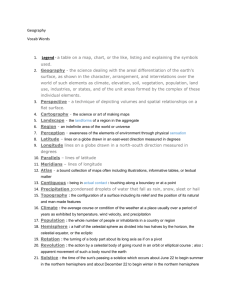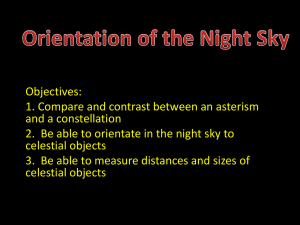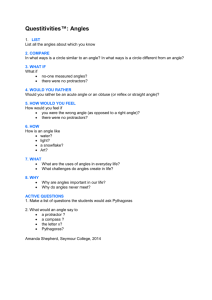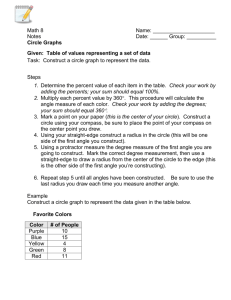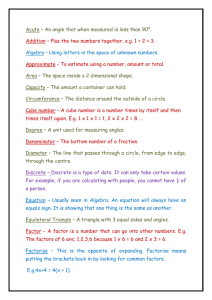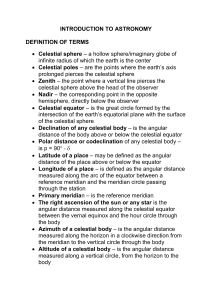SURVEYING II
advertisement
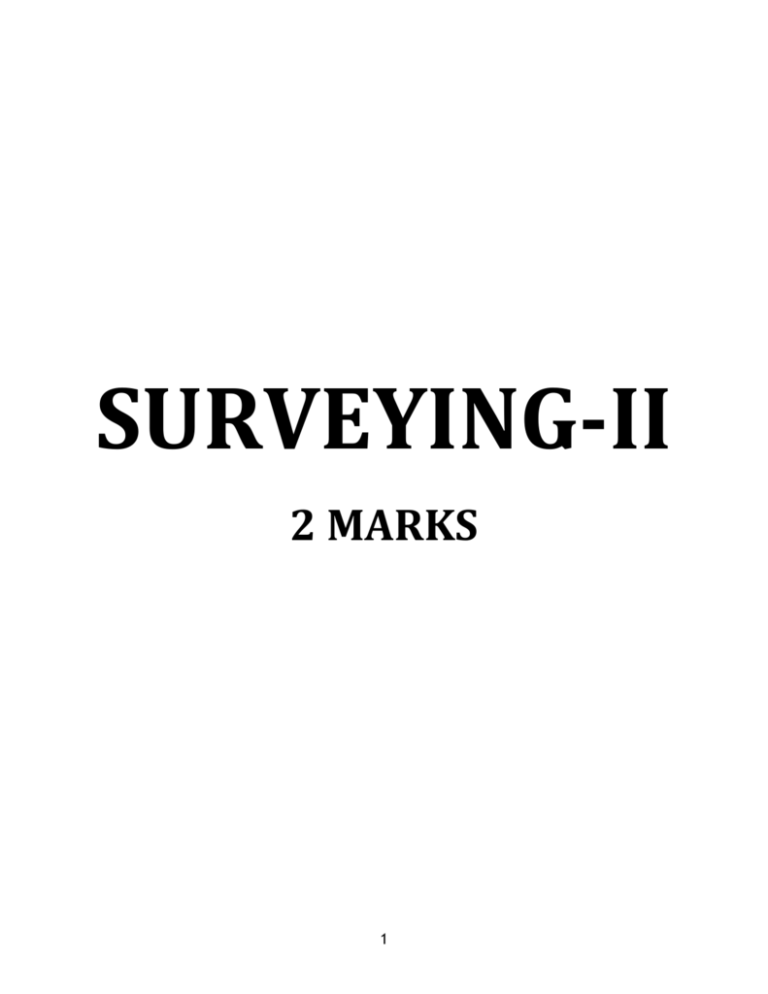
SURVEYING-II 2 MARKS 1 UNIT-I 2-Marks 1. Define Tacheometry: Tacheometry is a branch of angular surveying in which the horizontal and vertical distances (or) points are obtained by optional means as opposed to the ordinary slower process of measurements by chain (or) tape. 2. Define Tacheometer: It is an ordinary transit theodolite fitted with an extra lens called analytic lens. The purpose of fitting the analytic lens is to reduce the additive constant to zero. 3. Define Analytic lens: Analytic lens is an additional lens placed between the diaphragm and the objective at a fixed distance from the objective. This lens will be fitted in ordinary transit theodolite. After fitting this additional lens the telescope is called as external focusing analytic telescope. The purpose of fitting the analytic lens is to reduce the additive constant to zero. 4. Define Substance bar: A Substance bar is manufactured by Mr. Kern. The length of the substance bar is 2m (6ft) for measurement of comparatively short distance in a traverse. A Substance bar may be used as a substance base. The length of the bar is made equal to the distance between the two targets. 5. What are the merits and demerits of movable hair method? Merits: Long sights can be taken with greater accuracy than stadia method The error obtained is minimum Demerits: The computations are not quicker Careful observation is essential 6. Fixed hair method: In this method, the stadia wires are fixed (or) fitted at constant distance apart. 7. Staff intercept: The difference of the reading corresponding to the top and bottom stadia wires. 8. Stadia intercept: The difference of the distance between the top and bottom cross hairs. 9. Sub tense method: 2 In this method stadia interval is variable. The staff intercept is kept fixed while the stadia interval is variable. 10. The tangential method: In this method, the stadia hairs are not for taking readings. The readings being taken against the horizontal cross hair. 11. What are the systems of tacheometry measurements? The stadia system The tangential system Measurement by means of special instrument. 12. What are the types of stadia system? Fixed hair method, Movable hair method 13. What is the principle of stadia method? The method is based on the principle that the ratio of the perpendicular to the base is constant to similar isosceles triangle. 16-Marks 1. The following readings were taken on a vertical staff with a tacheometer fitted with an anallatic lens and having a constant of 100. Vertical Staff station Bearing Staff readings A 47o 10’ 0.940 1.500 2.060 8o0’ B 227o 10’ 0.847 2.000 3.153 -5o0’ angles Calculate the relative level of the ground at A and B and the gradient between A and B. 2. How do you calculate the horizontal and vertical distances between a instrument station and a staff station when the line of collimation is inclined to the horizontal and the staff is held vertically. 3. Explain the procedure of estimating the horizontal and vertical distances where the line of collimation is inclined to the horizontal and the staff is held normal to the line of collimation 4. The following notes refer to a line leveled tacheometrically with an anallatic tacheometer, the multiplying constant being 100: 3 Inst. Station Height of axis Vertical Staff Stations Angle Hair readings Remarks P 1.5 B.M -6o 12’ 0.963,1.515,2.067 R.L of B.M. P 1.5 Q +7o 5’ 0.819,1.341,1.863 = 460.65 m Q 1.6 R +12o 27’ 1.860,2.445,3.030 staff held vertically. Compute the reduced levels of P.Q and R and the horizontal distances PQ and QR. 5. A tacheometer is setup at an intermediate point at on a traverse course PQ. The following observations are made on the vertically held staff. Staff station Vertical angle Staff intercept Arcial hair reading P 80 36 1 2.350 2.105 Q 6061 2.055 1.895 The Instrument is fitted with an anallactic lens and the constant is too- compute the length of PQ and R-C of Q that of P being 321.5 m. 6. Calculate the horizontal and vertical distances using tangential tacheometry when both the observed angles are angle of elevation and angle of depression. 7. Tacheometer was setup at a Station A and readings are taken on vertically held staff at B were 2.255, 2.605 and 2.955. The line of sight being at an inclination 80 241. Another set of observation on the vertically held staff at B.M gave the readings 1.640, 1.920 and 2.200 respectively. The inclination of the line of sight being 20 151. Calculate the horizontal distance between A + B and the elevation of B if the R.C of B.M is 418.685 M. The constants of the instruments were 100 & 0.30. 4 UNIT-II 2-Marks 1. Permanent Bench mark: These are established by different government departments like PWD, Railways, Irrigation etc., The RL of these points are determined with reference to G.T.S Benchmarks. Points on rocks, culvert, gate, pillars etc. 2. Temporary Bench mark: These are established temporarily whenever required. These are generally chosen to close the day’s work and to start the next days. Points on roofs, walls, basements etc 3. Arbitrary Bench Mark: When the RL of some fixed Points are assumed, they are termed a arbitrary Bench mark 4. Extension of baseline: The length of baseline is usually not greater than 10 to 20 km. As it is not a often possible to sewed a favorable sight for a longer base. They usually practice is therefore to use short base & Extend it by means. Of forming well conditioned triangles. 5. Trigonometrical levelling: Trigonometrical levelling is the process of determining the differences of elevation of the given station from observed vertical angles and known distance. 6. Axis Signal correction : If the height of the signed is not the same as that of height of the instrument axis above the station, a correction known as the axis signal correction or eye & objective correction is to be applied. 7. Geodetic Surveying : In this surveying, the shape of the earth is taken into account and all the lines lying in the surface are curved lines. It is used for area greater than 250km2. It is accurate. It is conducted by great geometrical survey of India. 8. Baseline : The Base line is laid down with great accuracy of measurement & alignment as it forms the basis for the computations of triangulation system the length of the base line depends upon the grades of the triangulation. 9. Laplace Station : At certain station, astronomical observations for azimuth & longitude are also made on the station is called Laplace station 5 10. Triangulation : Triangulation is nothing but the system consists of not of interconnected triangles. In this method, knowing the length of one side and three angles, the length of other two sides of each triangle can be computed. 11. Signals : A Signal any object such as a pole target erected at a station upon which a sight is taken by a observer at another station. 12. Satellite Station : A subsidiary station is established as near the true or principal station as possible, the station so established is called a satellite station or eccentric station or false station. 13. Reduction to centre: If the true station were occupied by computing the corrections and apply them algebraically to the observed values is generally known as reduction of centre. 14. Base net: A series of triangles connecting the baseline to the main triangulation is called base net. 15. Bench marking : It is a fined reference point of known elevation. 16. Types of Bench Mark: Great Trigonometric survey Bench mark Permanent Bench mark Arbitrary Bench mark Temporary Bench mark 17. Equipments used for base line measurement: Marking stakes or tripod Straining device Supporting stakes or tripod Steel tape Six number of thermometer. 18. Methods used to measure baseline Rigid bar method Wheeler’s method Jaderin’s method Hunter’s short base method 6 Tacheometric method 19. Two types of Trigonometrically leveling: Plane Trigonometrical levelling Geodetic Trigonometrical levelling 20. Apparatus used in Baseline: Rigid Bars Flexible apparatus 21. Corrections made while calculation of true length Correction for absolute length Correction for temperature Correction for pull or tension Correction for Sag Correction for Slope 16-Marks 1. What are the different corrections to be applied while measuring baseline in geodetic surveying? 2. A steel tape 30m long, standardized at 10 o c with a pull of 100N was used for measuring a baseline. Find the correction per tape length, if the temperature at the time of measurement was 20oc and pull applied was 150 N. Density of steel = 3000 kg/m3. Weight of tape=5.88N. 3. What is meant by a “satellite station”? 4. In a trignometrical measurement of the difference in level of two stations P and Q, 10480 m apart, the following data were obtained. Instrument at P, angle of elevation of Q = 0’15” Instrument at Q, angle of depression of P = 3’ 33” Height of instrument at P = 1.42 m. Height of instrument at Q = 1.45 m. Height of signal at P = 3.95 m. Height of signal at Q = 3.92 m. Find the difference in level between P and Q and the curvature and refraction correction. Take R sin 1” = 30.38m. 5. From an eccentric Station S, 12.25 metres to the west of the main station B, the following angles were measured BSC = 760251; CSA = 540321 2011. 7 The stations S and C are to the opposite sides of the line AB. Calculate the angle ABC if the lengths AB and BC are 5286.5 and 4932.2m 6. correct respectively. What are the methods of measurement of the base line and explain any two with neat sketch. 7. A steel tape is 30 m long at a temp of 15ºc when lying horizontal on the ground. Its c/s area is 0.08 cm2 and weight of 18.kg (18N) and. Co-eff of expansion is 117 x10-7/ºc. The tape is stretched over 3 supports which are at the same level and at equal intervals. Calculate the actual length between the end graduations under the following conditions. Temp = 25ºc, Pull -180 kgt, E = 2.1 x 105 N/cm 2. 8 UNIT-III 2-Marks 1. Errors: Mistakes (or) gross Errors Systematic (or) Cumulative Errors Accidental (or) Random Errors 2. Mistakes (or) Gauss Errors: Depends upon the observer, a mistake cannot be corrected unless the observer get training. The mistakes are errors that arise from inattention, inexperience, carelessness and poor judgement of confusion in the mind of observer. 3. Systematic Errors: The systematic error is an error that under the same conditions will always be of the same size and sign. It is simply due to the error in instrument. These errors may be regarded as positive or negative according with whether they make the result too small (or) too great. This effect is cumulative. 4. Accidental Errors: The Accidental Errors are those which remain after mistakes and systematical errors have been eliminated and are caused by the combination of reasons beyond the ability of the observer to control. 5. Classification of Observer Quantity: An observer quantity may be classified as Independent Quantity Conditioned Quantity 6. Independent Quantity: It is the one whose value is independent of the values of other quantities. It bears no relation with any other quantity and hence change in the other quantities does not affect the value of this quantity. eg. R.L of B.M 7. Conditioned Quantity: It is the one whose value is dependent upon the values of one (or) more quantities. Its values bear a rigid relation to some other quantities. It is also called “dependent quantities”. 8. Conditioned Equation: The conditioned equation is the equation expressing the relation existing b/w the several dependent quantities. eg. In a ABC A+B+C= 180 . It is a conditioned equation. 9 9. Observation: An observation is a numerical value of the measured quantity and may be either direct (or) indirect. 10. Direct Observation: A direct observation is the one made directly on the quantity being determined. Eg: Measurement of base line. 11. Indirect Observation: An indirect observation is one in which the observed value is deduced from the measurement of some related quantities. Eg: Measurement of Angle by repetition method. 12. Weight of an Observation: The weight of an observation is a number giving an indication of its precision and trust worthiness, when making a comparison between several quantities of different worth. If a certain observation of weight 4 it means that it is 4 times as much reliable as an observation of weight 1. When two quantities (or) observations are assumed to be equally reliable, the observed values are said to be of equal weight (or) of unit weight. 13. Weighted Observations: Observations are weighted when different weights are assigned to them. Eg: A=30040’- wt 3 It means A is measured 3 times. 14. Observed value of a Quantity: An observed value of a quantity is a value obtained when it is corrected for all the known errors. Observed value = Measured value ± errors (or) corrections. 15. True value of Quantity: It is the value which is obsolute free from all the errors. 16. True Error: A true error is the difference b/w the true value of the quantity and its observed value. True value = True value – observed value The most probable value of the quantity is the value which is more likely to be the true value then any other value. 17. Most probable Errors: It is defined as the quantity which added to and subtracted from the most probable value, fixes the limit within which it is an even chance the true value of the measured quantity must lie. 10 18. Residual Error: It is diff b/w the most probable value of the quantity and its observed value. Residual Errors = most probable value – observed value 19. Observation Equation: It is the relation b/w the observed quantity and its numerical value. 20. Normal Equation: It is the education which is formed by the multiplying each equation by the co-efficient of the unknown, whose normal equation is to be formed out by adding the equation thus formed. 16-Marks 1. What do you mean by station adjustment? Explain. 2. The following are the three angles α β and γ observed at a station P closing the horizon, along with their probable errors of measurement. Determine their corrected values α = 78o 12’ 12” ± 2” β = 136o 48’ 30” ± 4” γ = 144o 59’ 08” ± 5” 3. What do you mean by figure adjustment? Explain 4. Find the most probable values of the angles A, B and C from the following observations at a station P using method of differences. 5. A = 38o 25’ 20” wt.1 B = 32o 36’ 12” wt.1 A +B = 71o 01’ 29” wt .2 A + B+ C = 119 o 10’ 43” wt.1 B + C = 80o 45’ 28 wt.2 Form the normal equation for x, y, z in the following equations. 3X+3Y+Z-4=0 X+2Y+2Z-6=0 5X+Y+4Z-21=0 Also form the normal equation, if weights of the equations are 2, 3 and 1 respectively. 6. The following angles were measured at a station O so as to close the horizon A=8304212811.75 wt.3 B=10201514311.26 wt.2 C=9403812711.22 wt.4 D=7902312311.77 wt.2 Adjust the angles by method of correlates. 11 UNIT- IV 2-Marks 1. Celestial sphere : It is an imaginary sphere on which the stars appear to lie or to be studded is known as the Celestial sphere. 2. Zenith (z) : It is the point on the upper portion of the celestial sphere marked by plumb line above the observer. It is the point on the celestial sphere immediately above the observer’s station. 3. Nadir (Z’, or, N): It is the point on the lower portion of the celestial sphere marked by plumb line below the observer. It is the point on the celestial sphere vertically below the observer’s station. 4. Celestial Horizon: It is also called true or Rational horizon or geocentric horizon. It is the great circle traced upon the celestial sphere by that plane which is perpendicular to the zenith –Nadir line and which passes through the centre of the earth. 5. The terrestrial poles and equator : The terrestrial poles are the two points in which the earth’s axis of notation meets the earth’s sphere. The terrestrial equator is the greet circle of the earth, the plane of which is at right angles to the axis of notation. The two poles are equidistant from it. 6. The celestial poles and equator : If the earth’s axis of rotation is produced indefinitely, it will meet the celestial sphere in two points called the North & South celestial poles (P and P’). The celestial equator is the great circle of the celestial sphere in which it is intersected by he plane or terrestrial equator. 7. Sensible horizon: It is a circle in which a plane passing through the point of observation and tangential to the earth’s surface intersects with celestial sphere. The line of sight of an accurately leveled telescope lies in this plane. 8. Visible horizon : It is a circle of contact, with the earth, of the cone of visual rays passing through the point of observation. 12 9. Vertical circle : A vertical circle of the celestial sphere is great circle passing through the zenith and nadir. They all cut the celestial horizon at right angles. 10. The Observers Meridian: The meridian of any particular point is that circle which passes through the zenith and nadir of the point as well as through the poles. 11. Prime vertical: It is the particular vertical circle which is at right angles to the meridian and which therefore passes through the east & west points of horizon. 12. Latitude (θ): It is the angular distance of any place on the earth’s surface north or south of the equator, and is measured on the meridian of the place. It is also defined as the angle between the zenith and the celestial equator. 13. The co-latitude : The co-latitude of a place is the angular distance from the zenith to the pole. It is the complement of the latitude and equal to (900- θ). 14. The longitude (Ф): The longitude of a place is the angle between a fixed reference meridian called the prime or first meridian and the meridian of the place. 15. The altitude (α): The altitude of celestial or heavenly body (i.e., a sun or star) is its angular distance above the horizon, measured on the vertical circle passing through the body. 16. The co-altitude or zenith distance (z): It is the angular distance of heavenly body from the zenith. It is the complement of the altitude. 17. The Azimuth: The azimuth of a heavenly body is the angle between the observer’s meridian and the vertical circle passing through the body. 18. The Declination: The declination f a celestial body is angular distance from the plane of the equator, measured along the star’s meridian generally called the declination circle. Declination varies from 00 to 900, and is marked + or – according as the body is north or south of the equator. 19. Hour circle: 13 Hour circles are great circles passing through the north and south celestial poles. The declination circle of a heavenly body is thus its hour circle. 20. The hour angle: The hour angle of a heavenly body is the angle between the observer’s meridian and the declination circle passing through the body. The hour angle is always measured westwards. 16-Marks 1. 2. Write short notes on a) Sidereal time c) Mean solar time b) Solar Apparent time d) Standard time Find the Local mean time at a place in longitude 90o 40’ E. When the standard time is 10 hr, 32min, 34 sec and the standard meridian 82o 30’ E. 3. List the astronomical corrections and explain them? 4. Determine the azimuth and altitude of a star from the following data Latitude of the observer (θ) = 46o N Hour angle of star (H) = 45o 45’ Declination of star (S) = + 22o (N) UNIT-V 14 2-Marks 1. Hydrographic Survey: Hydrographic Survey is that branch of surveying which deals with the measurement of bodies of water. It is the art of delineating the submarine levels, contours and features of seas, gulfs, rivers and lakes. 2. Sounding : The measurement of depth below the water surface is called sounding. 3. Tides: All celestial bodies exert a gravitational force on each other. These forces of attraction between earth & other celestial bodies cause periodical variations in the level of water surface, known as tides. 4. Equilibrium Theory : The earth is covered all around by the ocean of uniform depth. The ocean is capable of assuming the equilibrium. 5. Mean sea level : Mean sea level may be defined as the mean level of the sea, obtained by taking the mean of all the height of the tide as measured at hourly intervals over some states period covering a whole number of complete tides. 6. Fathometer : A fathometer is used for ocean sounding where the depth of water is too much and to make a continuous and accurate record of depth of water below the boat or ship at which it is installed. 7. Photographic Survey : It is also called photogrametry. It is a method of surveying in which plant or maps are prepared from photographs taken from Suitable camera station. It is divided into two. Terrestrial photography Aerial photography 8. Photo theodolite: It is the combination of photo with theodolite and is used for taking photographs & measuring the angles which the vertical plane of collimation makes with the base line. 9. Stereoscopic pairs: It means two photos are obtained for a Single object from two point one at each. 10. Parallax: 15 In normal binocular vision the apparent movement of a point viewed first with one eye and then the other is known a parallax. 11. Angle of Parallax: It is the angle of convergence of the two rays of vision. 12. Stereoscopic fusion: If a pair of photographs is taken of an object from two slightly different positions of the camera and then viewed by an apparatus which ensures that the left eye sees only the lefthand picture & right eye is directed to the right hand picture, the two separate images of the object will fuse together is the brain to provide the observer with spatial impression. This is known as a Stereoscopic fusion. 13. Stereo pair: The pair of two such photographs is known as stereo pair. The effect of distortions exist in a single photograph may be eliminated through a large extend of stereo pairs. 14. Parallax bar: A parallax bar used to measure difference of two points, consists of a bar which holds a fixed plate of transparent material near the left end and a movable plate to the right end. 15. Floating mark: In parallax bar, when the two dots are viewed properly under a stereoscope they fuse into a single dot called floating mark. 16. Mosaics : Such an assembly of getting series of overlapping photograph is called mosaic. 17. Types of EDM instrument : Tellurimeter Geodimeter Distomats 18. Cartography : It is the marking and study of maps in all their aspects. It is an important branch of graphics, since it is an extremely efficient way of manipulating, analyzing, & expressing ideas, forms & relationships that occur in two & three dimensional space. 19. Cadastral survey : Cadastral means, “Registration concern Land Survey”. It is of one of based on national land survey based on land survey law. 20. Modulation : 16 Amplitude modulation Frequency modulation In amplitude modulation, the carrier wave has constant frequency & the modulating wave (the measurement wave) in formation is conveyed by the amplitude of the carrier wave. In the frequency modulation the carrier wave has constant amplitude, while the frequency varies in proportion to the amplitude of the modulation wave. 21. Methods of Measuring Velocity flow: Surface float Sub surface float Velocity ropes Picot tube method &Current meter mean. 16-Marks 1. Explain briefly components of hydrographic survey? 2. Comparison between Air photographs and maps 3. What are the methods of locating soundings? 4. Define stereoscope and list out the types of stereoscopes? 5. State the equipment used for soundings and explain them. 6. State stereoscope and explain briefly the basic types of stereoscopes. 7. Explain briefly about the Electro-Magnetic Distance measurement. 17



